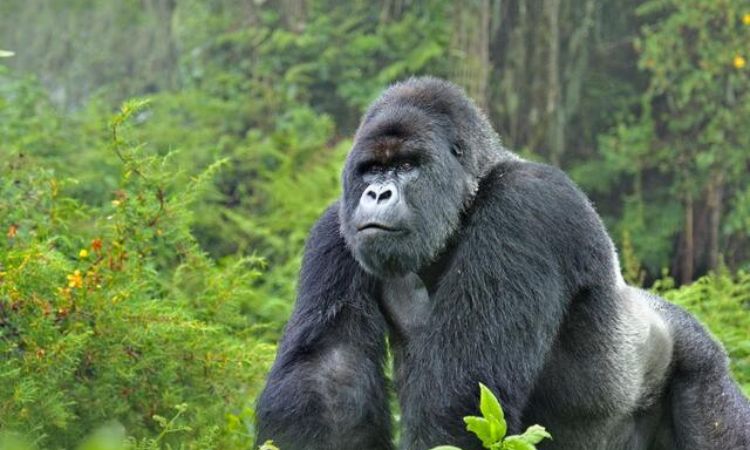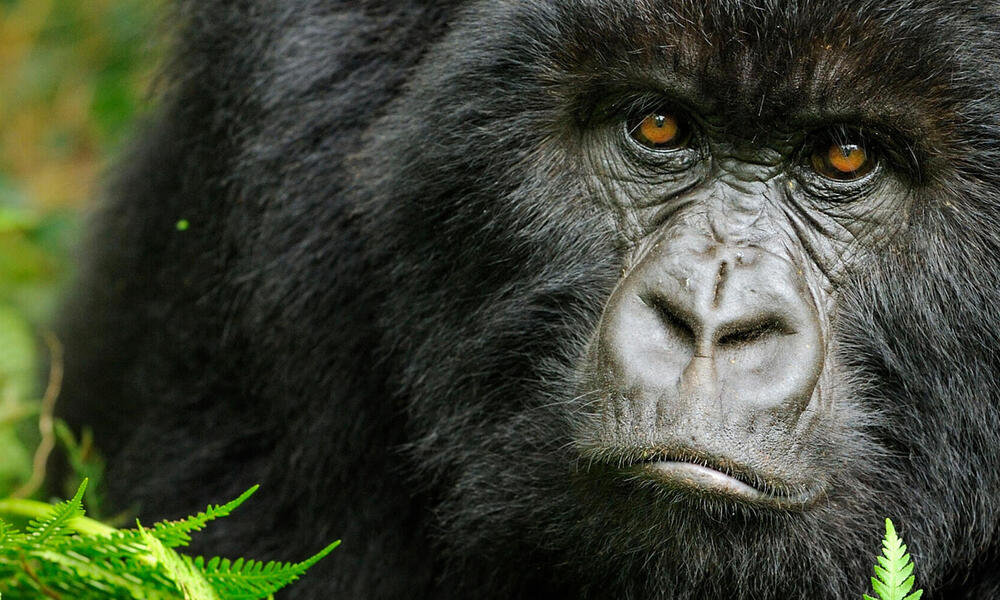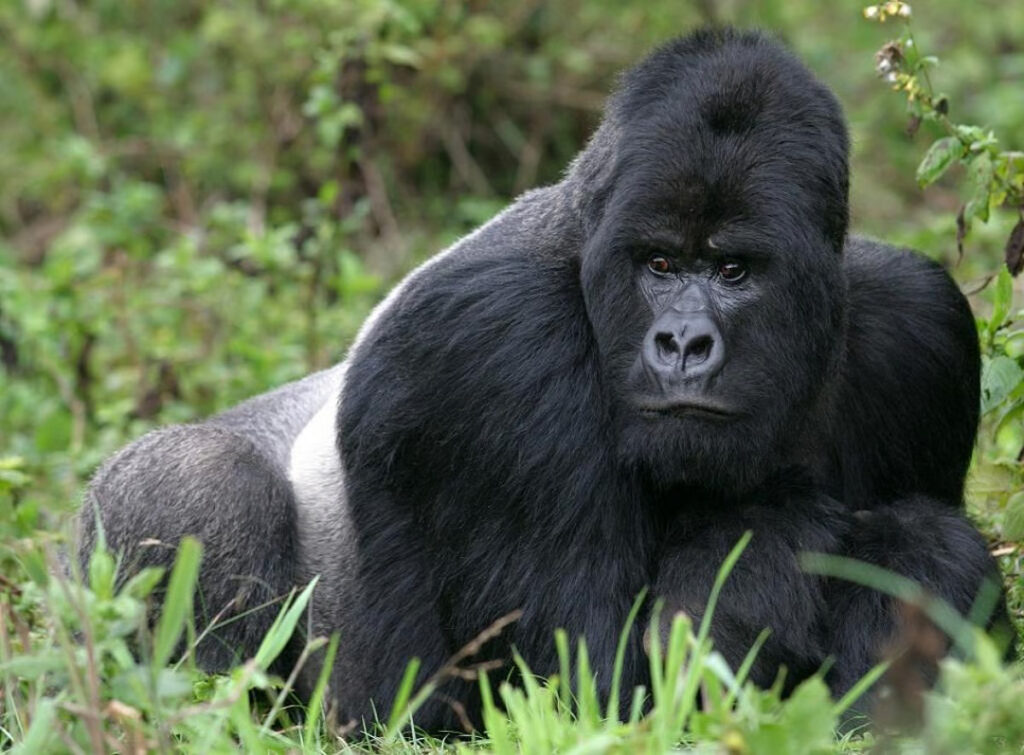20 Amazing Silverback Gorilla Facts You Didn’t Know
Silverback Gorilla Facts: Discover incredible facts about silverback gorillas — their strength, size, diet, and role as gentle giants of the forest.
The silverback gorilla, a majestic and powerful primate, commands awe with its sheer strength and calm leadership. As one of our closest relatives, sharing up to 98% of human DNA, this great ape captivates researchers, conservationists, and wildlife enthusiasts alike.
From their immense physical power to their intricate social structures, silverback gorillas are a testament to nature’s complexity.
In this comprehensive guide, we’ll explore fascinating silverback gorilla facts, covering their strength, size, behavior, diet, habitat, and more, while shedding light on their endangered status and where you can see them in the wild.
What Is a Silverback Gorilla?
A silverback gorilla is an adult male mountain or eastern lowland gorilla, typically over 12 years old, distinguished by the silver-gray hair that develops on its back.
This iconic feature signals maturity and dominance, as silverbacks lead and protect their family groups, known as troops.
A troop usually consists of one silverback, several females, and their offspring, ranging from 5 to 30 members. The silverback’s role is pivotal—it makes decisions, mediates conflicts, and defends the group from threats, whether from rival males or external dangers.

Physical Features of a Silverback Gorilla
Silverback gorillas are imposing creatures with remarkable physical traits. Standing between 4 and 6 feet tall when upright, they can weigh between 140 and 270 kg (310–600 lbs), with some exceptional individuals tipping the scales at even higher weights.
Their robust build includes a broad chest, muscular arms, and large canine teeth used for display and defense. The silver hair on their back, which gives them their name, contrasts with their dark fur, making them easily recognizable.
Their hands and feet are adapted for both knuckle-walking and grasping, showcasing their versatility in navigating dense forest environments.
How Strong Is a Silverback Gorilla?
One of the most jaw-dropping silverback gorilla facts is their incredible strength. A silverback is estimated to be up to 10 times stronger than an average human, capable of lifting over 1,800 kg (4,000 lbs) in short bursts—equivalent to lifting a small car.
This power comes from their dense muscle mass and robust skeletal structure. To put this in perspective, here’s a comparison of strength and physical attributes:
|
Feature |
Silverback Gorilla |
Human |
Chimpanzee |
|
Strength |
10x stronger |
1x |
5x stronger |
|
Weight |
140–270 kg |
60–90 kg |
40–60 kg |
|
Height (standing) |
4–6 ft |
5–6 ft |
3–4 ft |
This table highlights the silverback’s dominance in physical prowess, making it one of the strongest primates in the animal kingdom.
Silverback Gorilla Behavior and Social Structure
Silverback gorillas are the epitome of calm authority, leading their troops with intelligence and care. They live in close-knit family groups, where the silverback is the undisputed leader.
His responsibilities include protecting the troop, guiding them to food sources, and resolving disputes among members.
Despite their intimidating appearance, silverbacks are generally peaceful and only display aggression when their troop is threatened.
Their social behavior is complex. Silverbacks communicate through vocalizations, body language, and iconic displays like chest-beating, which serves to assert dominance or deter rivals.
These displays, often accompanied by roars and ground-slapping, are more about intimidation than actual violence. Within the troop, silverbacks foster strong bonds with females and their offspring, often playing with the young and grooming other members to reinforce social ties.
Silverback Gorilla Diet and Feeding Habits
Silverback gorillas are primarily herbivores, with a diet consisting of leaves, stems, shoots, fruits, and occasionally small insects like termites.
An adult silverback consumes up to 30 kg (66 lbs) of vegetation daily to sustain its massive frame. Their foraging habits are meticulous, as they carefully select nutrient-rich plants in their forest habitats.
In areas with abundant fruit, such as during certain seasons, they may prioritize fruit over leaves, showcasing their adaptability.
Their diet also influences their environment. By dispersing seeds through their waste, silverbacks contribute to forest regeneration, playing a vital role in their ecosystem. Conservationists note that protecting gorilla habitats ensures the survival of countless other plant and animal species.
Habitat and Range
Silverback gorillas inhabit the dense forests of Central and East Africa, primarily in Uganda, Rwanda, and the Democratic Republic of Congo (DRC).
Mountain gorillas, a subspecies, are found in high-altitude forests, while eastern lowland gorillas roam lower elevations. Key locations to spot silverback gorillas include:
- Bwindi Impenetrable National Park (Uganda): Home to nearly half of the world’s mountain gorilla population.
- Volcanoes National Park (Rwanda): A prime destination for gorilla trekking.
- Virunga National Park (DRC): A biodiversity hotspot, though access can be limited due to security concerns.
These parks offer lush, misty forests that provide ideal conditions for gorilla survival, with abundant vegetation and protection from predators.

Silverback Gorilla Lifespan and Reproduction
In the wild, silverback gorillas live between 35 and 45 years, though they can reach up to 50 years in captivity with proper care.
Reproduction is a slow process, with females giving birth to one infant every 4 to 6 years after a gestation period of about 8.5 months.
Newborns are highly dependent, clinging to their mothers for the first few years. The silverback plays a protective role, ensuring the safety of the young and fostering a stable family environment.
Interestingly, young males may challenge the dominant silverback for leadership as they mature. These challenges can lead to intense displays or, in rare cases, physical confrontations. If defeated, the silverback may leave to form a new troop or live a solitary life.
Are Silverback Gorillas Dangerous?
Despite their formidable strength, silverback gorillas are generally peaceful and shy. They avoid conflict unless provoked or if their troop is threatened.
Their aggressive displays—chest-beating, roaring, and charging—are often bluffs meant to intimidate rather than harm.
For humans, encounters with silverbacks are safe when guided by trained professionals during gorilla trekking. Respecting their space and following park guidelines ensures harmonious interactions.
Conservation Status
Silverback gorillas, particularly mountain gorillas, are classified as Endangered by the International Union for Conservation of Nature (IUCN).
Their populations face threats from habitat loss due to deforestation, poaching, disease (such as Ebola), and human-wildlife conflict.
However, conservation efforts have shown promise. In 2018, mountain gorilla numbers surpassed 1,000, a significant recovery from their critically endangered status decades ago.
Eco-tourism plays a crucial role in their survival. Gorilla trekking permits, which cost between $700 and $1,500 depending on the country, fund conservation programs and local communities.
Organizations like the World Wildlife Fund (WWF) and the Dian Fossey Gorilla Fund also work tirelessly to protect gorilla habitats and combat poaching.
Where to See Silverback Gorillas
For those eager to witness silverback gorillas in their natural habitat, gorilla trekking is a bucket-list experience. The best destinations include:
- Bwindi Impenetrable National Park, Uganda: Offers multiple trekking sectors, with permits costing around $700. Best seasons are June–September and December–February (dry seasons).
- Volcanoes National Park, Rwanda: Known for accessible trails and high success rates for sightings. Permits cost $1,500.
- Virunga National Park, DRC: Offers a more adventurous experience but requires careful planning due to regional instability. Permits are around $400–$500.
Treks typically last 2–7 hours, depending on the gorillas’ location, and are guided by expert rangers. Visitors are advised to book permits well in advance due to limited availability.
FAQ Section
Q1: How strong is a silverback gorilla?
A silverback gorilla is up to 10 times stronger than a human, capable of lifting over 1,800 kg (4,000 lbs).
Q2: Are silverback gorillas dangerous to humans?
They are generally peaceful but may become aggressive if their troop is threatened. Guided treks ensure safe encounters.
Q3: Where can I see silverback gorillas in Africa?
Prime locations include Bwindi Impenetrable National Park (Uganda), Volcanoes National Park (Rwanda), and Virunga National Park (DRC).
Q4: How long does a silverback gorilla live?
Silverbacks live 35–45 years in the wild and up to 50 years in captivity.
Conclusion
The silverback gorilla stands as a symbol of strength, intelligence, and family unity in the wild. From their awe-inspiring power to their gentle leadership, these primates remind us of our deep connection to the natural world.
By supporting conservation efforts and experiencing their majesty through responsible eco-tourism, we can ensure that future generations will continue to marvel at these gentle giants.
Whether you’re planning a trek to see them or simply fascinated by their lives, silverback gorillas are a testament to nature’s enduring wonders.
